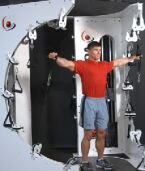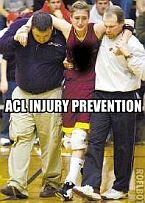Disc Herniations
Many terms are used by health care professionals to describe injury, damage, or degeneration to the spinal discs. The purpose of this article is to describe these terms. A brief review of spinal anatomy is necessary to understand these terms.
One important note: a disc herniation cannot be seen on regular X-rays; it can only be seen on MRI. Regular X-rays show disc degeneration, which shows up as a decrease in space between the vertebrae.
ANATOMY
The spinal column is comprised of 24 bones called vertebrae. These 24 vertebrae are divided into three areas: the neck or cervical spine which has seven vertebrae, the middle back or thoracic spine which has 12 vertebrae, and the lower back or lumbar spine which has five vertebrae. The bone at the base of the spine is called the sacrum. At the end of the sacrum is the coccyx.
In between each pair of vertebrae is a disc or shock-absorbing cushion. There are 23 discs in the spine starting between the second and third cervical (neck) vertebrae and continuing to the last disc between the fifth lumbar (low back) vertebra and the sacrum (bone at base of spine). The discs are named by using the vertebrae above and below, i.e., C2-C3, T5-T6, and L4-L5. The letter "C" stands for cervical, the letter "T" stands for thoracic (mid-back), the letter "L" stands for lumbar and the letter "S" stand for sacrum. In the example above, C2-C3 is the disc between the second and third cervical vertebrae.
The spinal cord is a direct continuation of the brain that passes through a hole in the skull (foramen magnum or big hole) and through holes in each vertebra called the spinal canal. In-between each pair of vertebrae are holes on both the right and left through which branches of the spinal cord run called a nerve roots. In the cervical spine these nerve roots travel down the arm and control the muscles of the arms and all the muscles around the shoulder and shoulder blades as well as the feeling in the arms. In the thoracic spine they run around the ribs and to the internal organs and in the lumbar spine they run to the sexual organs and the hips, thighs, legs, and feet.
The disc is comprised of a strong outer material called the annulus fibrosis that has concentric rings quite similar to a cut tree trunk as seen from above. These concentric rings receive nutrients through osmosis, as they have no arteries or veins directly. The center of the disc is called the nucleus pulposus. This fluid (water)-filled jelly sack, similar to the inside of the gum you can bite into and the middle squirts out, can be pushed out by compressive forces down the spinal column. The disc provides a shock absorbing effect that dissipates these compressive forces across multiple levels in the spine and still allows for the flexibility required for performing normal activities of daily living. Thus, as the body twists, bends, flexes and extends; the discs are constantly changing their shape.
DISC TERMINOLOGY
Over a lifetime the disc can be damaged by acute injuries like auto accidents and falls or by chronic insult like poor posture, weak and inflexible supporting muscles, and poor body mechanics. These injuries can cause the annulus, the outer layer of the disc, to tear.
A disc bulge means that contour of the outer rings (annulus) extends, or appears to extend, in the horizontal (axial) plane beyond the edges of the disc space, over greater than 50% (180 degrees) of the circumference of the disc and usually less than 3mm beyond the edges of the vertebral body apophyses.
SOURCE: American Journal of Neuroradiology: Nomenclature and Classification of Lumbar Disc Pathology
A disc bulge is due to tears in the annulus allowing disc material to enlarge the disc in the form of a bulge; similar to the way an old tire might bulge out. Think of it as a slow leak. The nucleus (jelly like middle) of the disc "squirts" through some of the torn annular fibers, but not through all the fibers. This bulge may press straight back or to either side, depending on location of the annular tears. A bulge may or may not cause symptoms.
A disc herniation is a "localized displacement of disc material beyond the normal margins of the intervertebral disc space." "Herniated disc generally refers to displacement of disc tissues through a disruption in the anulus." "Herniated disc is sometimes referred to as "herniated nucleus pulposus," but the term herniated disc is preferred because displaced disc tissues often include cartilage, bone fragments, or anular tissues. The term "ruptured disc" is used synonymously with herniated disc, but is more colloquial and can be easily confused with violent, traumatic rupture of the anulus or end-plate." "The term herniated disc does not infer knowledge of cause, relation to injury or activity, concordance with symptoms, or need for treatment." Think of a disc hernition as a tire blow-out.
SOURCE: American Journal of Neuroradiology: Nomenclature and Classification of Lumbar Disc Pathology
The term prolapsed disc has also been used as a general term for disc displacement, but its use has been inconsistent. "Medically, it usually means to fall out and down, as with prolapse of the rectum or uterus. Analogy to the disc would apply most closely to disc tissue that has displaced beyond the disc space into the supra-pedicular zone. It has been used often, non-specifically, as synonymous with herniation. Prolapse is not a recommended term for description of disc displacement."
SOURCE: American Journal of Neuroradiology: Nomenclature and Classification of Lumbar Disc Pathology
A protruded disc is "disc in which disc tissue beyond the disc space is contained within intact anulus." "A disc that has broken through the outer anulus at the apex, but maintains a broad continuity at the base, is protruded and uncontained. While sometimes used as a general term in the way herniation is defined here, the use of the term protrusion is best reserved for sub-categorization of herniations meeting the above criteria." The outer ring of the annulus has not been breached, in other words, no disc material has completely squirted through the outer edges of the disc.
SOURCE: American Journal of Neuroradiology: Nomenclature and Classification of Lumbar Disc Pathology
An extruded disc, or transligamentous disc ("displacement of disc material through the posterior longitudinal ligament") occurs when the annulus tears all the way through and some disc material actually pushes out beyond the boundaries of the disc and nearby ligaments, but has not broken away from the disc itself. "The preferred definition is consistent with the common language image of extrusion as an expulsion of material from a container through and beyond an aperture. Displacement beyond the outer anulus of disc material with any distance between its edges greater than the distance between the edges of the base distinguishes extrusion from protrusion. Distinguishing extrusion from protrusion by imaging is best done by measuring the edges of the displaced material and remaining continuity with the disc of origin, whereas relationship of the displaced disc material to the aperture through which it has passed is more readily observed surgically. Characteristics of protrusion and extrusion may co-exist, in which case the disc should be subcategorized as extruded. Extruded discs in which all continuity with the disc of origin is lost may be further characterized as sequestrated. Disc material displaced away from the site of extrusion may be characterized as migrated."
SOURCE: American Journal of Neuroradiology: Nomenclature and Classification of Lumbar Disc Pathology
Finally, a sequestered or sequestrated disc "is an extruded disc in which a portion of the disc tissue is displaced beyond the outer anulus and maintains no connection by disc tissue with the disc of origin." It occurs when the herniated disc material completely separates from the disc and becomes a free fragment, which floats around, just like a loose piece of cartilage in the knee. "If even a tenuous connection by disc tissue remains between a displaced fragment and disc of origin, the disc is not sequestrated."
SOURCE: American Journal of Neuroradiology: Nomenclature and Classification of Lumbar Disc Pathology
Two other general terms are used when describing disc herniations: contained and uncontained. The distinction is important because contained disc herniations generally will respond well to conservation care (chiropractic adjustments and exercise rehabilitation) while uncontained disc herniations may not. A contained disc is "displaced disc tissue that is wholly within an outer perimeter of uninterrupted outer anulus or capsule." In other words, no blow-out.
SOURCE: American Journal of Neuroradiology: Nomenclature and Classification of Lumbar Disc Pathology
An uncontained disc is "displaced disc material that is not contained by uninterrupted outer anulus." Uncontained disc herniations need surgical intervention, while in the case of contained discs; conservative care should be tried first with surgery as a last resort.
SOURCE: American Journal of Neuroradiology: Nomenclature and Classification of Lumbar Disc Pathology
Dr. Fred Turner states, "Dont be confused by the terminology! The implication is, that a herniation is worse than a bulge; or that if bulge or herniation is not touching a nerve, that it will not be painful. These are common misconceptions that are held by doctors, as well as lay-people! THE KEY ISSUE IS THE ANNULAR TEAR!! The annular tear is, in and of itself, painful. And, it is the character of the annular tear, (i.e., how big it is, and whether it is longitudinal or radial), that determines whether the disc will bulge or herniate. The annular tear is analogous to a hole in a tire. The size of the hole determines if the tire will have a blow-out, or a slow-leak." Dr. Turner continues, "The truth is, in the vast majority of cases of low back pain, the bulge or herniation does NOT touch the nerve. And, when the bulge or herniation does touch the nerve, it causes LEG pain, not BACK pain! As our knowledge of low back pain has grown over the years, we have had to adjust our thinking. This misconception, however, seems to persist, despite what we have learned."
SOURCE: Dr. Fred Turner
Patients with disc herniations in the cervical, thoracic, or lumbar spine can present with neck pain, back pain, arm pain, leg pain or any combination of the above. As explained above, the pain may be due to the bugling or herniated disc pressing on either the spinal cord or a nerve root and/or due to the damage to the disc itself. The disc has its own nerve called the sinuvertebral nerve which monitors mechanical and chemical stimuli and whose purpose is to perceive pain.
SOURCE: Dr. Fred Turner
If the herniation occurs in the neck, it may cause pain in the neck and/or radiate into the shoulder, arm, and hand; if it occurs in the back, the pain produced may be in the back and/or radiate down into the hip, groin, leg, and foot. Sometimes, patients with disc herniations can present with weakness in an extremity or signs of spinal cord compression such as difficulty with gait, incoordination, or loss of bladder/bowel control. If symptoms include incoordination or loss of bladder/bowel control, immediate medical attention is necessary.
In many cases, people have disc herniations, but do not have pain. Conversely, the pain that a patient has may not be completely caused by the disc causing pressure on the nerve. It may come from the inflammation that occurs at the joints in the spine as well as tightness or spasm of the surrounding muscles. All these issues must be addressed when treating this problem.
TREATMENT OF CONTAINED DISC HERNIATIONS
Effective treatment includes many different forms of chiropractic manipulation, Active Release Technique®, Graston Technique®, Kinesio® Taping, Cold Laser, Ergonomic changes, Postural changes, and proper rehabilitative exercise. Vertetrac is a patented, state-of-the-art ambulatory traction system that we use with great success here at Maryland Sports Injury Center. The Vertetrac has been show to reduce disc herniations without the damage caused by surgery. Read more about the Vertetrac here!
DISC DEGENERATION (Degenerative Disc Disease)
As a part of the aging process, the discs begin to lose their high water content and their ability to dissipate force as efficiently. By the age of 35, approximately 30% of people will show evidence of disc degeneration at one or more levels. By the age of 60, greater than 90% of people will show evidence of disc degeneration at one or more levels on MRI. In some patients, this disc degeneration can be asymptomatic; in others, disc degeneration can lead to intractable back pain. The amount of disc degeneration - what many doctors call degenerative disc disease - frequently has no relationship to pain at all. Lack of flexibility and muscle weakness must be addressed when treating disc degeneration.
Disc degeneration cannot be reversed, but can be effectively slowed down and treated with chiropractic adjustments, exercise, and nutritional support (like bromelain for acute pain and glucosamine supplements for long term care).
|
The Ultimate Nutritional Lie Detector Test LEARN MORE 
|
Kettlebell Rehab

Click Here
To See How Kettlebells will transform your body!
Vortex Rehab

Click Here
To See How This
Revolutionary Machine
Can Help You!
Partner / Support

Loans up to 3 months - fast cash advances for up to 90 days and up to $5,000!


















